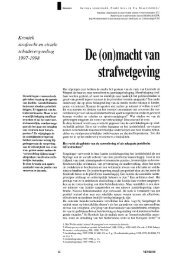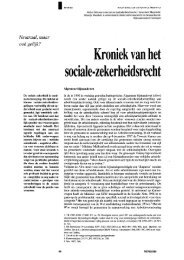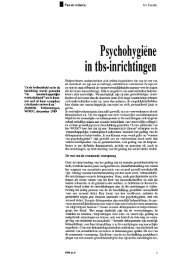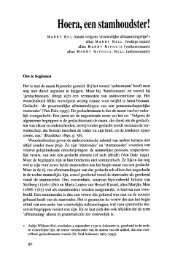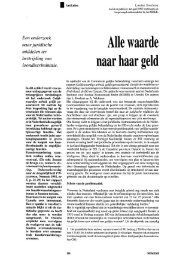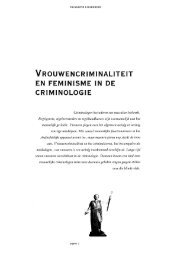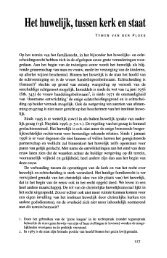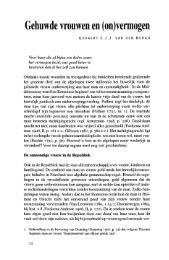(2003) nummer 3 mei/juni - Nemesis
(2003) nummer 3 mei/juni - Nemesis
(2003) nummer 3 mei/juni - Nemesis
You also want an ePaper? Increase the reach of your titles
YUMPU automatically turns print PDFs into web optimized ePapers that Google loves.
way that those interests are reasonably<br />
accommodated in order that women<br />
have de facto equal rights and equal<br />
opportunities. Article 4(2) therefore, is<br />
of an explanatory nature rather than an<br />
exception to the equal treatment norm.<br />
III The structure of the General<br />
Recommendation<br />
It has been suggested in the expert<br />
meeting that the GR should contain the<br />
following Sections 6 :<br />
1. The object and purpose of the Convention<br />
2.The meaning of TSMs in other Human<br />
Rights instruments/Constitutions/national<br />
legislation<br />
3. The meaning of the concept of TSMs<br />
in the CEDAW-Convention<br />
4. The mandatory nature of TSMs<br />
5. Article 4(1) in the reporting procedure<br />
6. Examples of TSMs in practice<br />
The following paragraphs present the<br />
recommendations of the expert meeting<br />
regarding the content of each of<br />
these Sections.<br />
IV The object and purpose of the<br />
Convention<br />
The GR should explain the role and<br />
function of Article 4( 1), given the o verall<br />
object and purpose of the CEDAW-<br />
Convention. Therefore, an explanation<br />
of the meaning of the Convention with<br />
respect to several issues is necessary.<br />
The Convention is a dynamic instrument.<br />
Given the progressive insights<br />
concerning the concept of equality of<br />
men and women and the instruments<br />
that are adequate and necessary to fight<br />
all forms of discrimination against<br />
women, it is only logical that 24 years<br />
after the adoption of the Convention<br />
there is a need for clarification of some<br />
of its central provisions.<br />
The a-symmetrical equality norm of the<br />
Convention<br />
In its Preamble and its provisions the<br />
CEDA W-Convention clearly embraces<br />
a substantive 7 and an a-symmetrical<br />
approach to non-discrimination<br />
and equality of men and women. This<br />
is in marked contrast to the formal 8 and<br />
symmetrical concept of equality and<br />
discrimination that is dominant in sex<br />
equality legislation in many countries.<br />
Often domestic legislation requires that<br />
there should be no unequal treatment or<br />
discrimination on the ground of sex.<br />
Thus, both men and women are equally<br />
protected against unfair and non-justifiable<br />
unequal treatment. It is irrelevant<br />
WETGEVING<br />
whether the claimant belongs to a<br />
group that is the victim of (past or present)<br />
discrimination or that he or she<br />
really is (structurally) in a disadvantaged<br />
position. Many men have won<br />
court cases under this legislation, often<br />
resulting in the abolishment of rules or<br />
practices aimed at the improvement of<br />
women's lives. Governments often follow<br />
apolicy of 'equally bad off is equal<br />
as well' and of 'levelling down' when<br />
implementing this formal and symmetrical<br />
sex equality norm.<br />
In contrast to this symmetrical approach<br />
the CEDA W-Convention prohibits<br />
any policy that - under the guise<br />
of equal treatment (of men) - would<br />
hurt the position of women. Such policies<br />
would be in breach of the obligation<br />
to improve the position of women<br />
(as reads the second aim of the Convention;<br />
see below). The Convention<br />
recognises the fact that women are the<br />
ones that have suffered and still suffer<br />
from a variety of forms of discrimination.<br />
The airris of the Convention<br />
The overall goal of the Convention<br />
(elimination of all forms of discrimination<br />
against women) can be 'subdivided'<br />
into three sub-aims. The CEDAW-<br />
Committee has already adopted this<br />
analysis in its Concluding Comments<br />
on the Netherlands of July 2001. 9 The<br />
Convention aims:<br />
- to ensure that there is no discrimination<br />
against women in the laws and in<br />
public administration,<br />
- to improve the de facto position of<br />
women and<br />
- to address the issue of fixed gender<br />
stereotypes (or the dominant gender<br />
ideology); ie. to bring about structural<br />
social and cultural changes that will facilitate<br />
diversity in gender roles.<br />
These three aims are derived from the<br />
joint reading of the Articles 1-5 and 24,<br />
which form the general interpretative<br />
basis of the Convention. Thus, the<br />
threefold approach of CEDAW moves<br />
far beyond the scope of formal equal<br />
rights (or mere equal treatment of<br />
women as compared to men). The three<br />
objectives of the Convention should<br />
not be separated or ranked, but should<br />
be read as three aspects of one and the<br />
same general goal: the elimination of<br />
all forms of discrimination against<br />
women. They imply that three different<br />
strategies are necessary in order to<br />
reach this overall purpose of the Convention.<br />
The Convention is concerned with far<br />
more than the individual right of<br />
women not to be discriminated against,<br />
which is embodied in Article 2. Rather,<br />
in Articles 3, 4 and 24 the Convention<br />
also emphasises the need for social<br />
support for women or certain groups of<br />
women in order to improve their position<br />
in society. Additionally, both the<br />
Preamble and article 5 a of the Convention<br />
recognise that fixed gender stereotypes<br />
are at the root of discrimination<br />
against women. The necessity to address<br />
this underlying cause of discrimination<br />
against women calls for a strategy<br />
for social and cultural change for the<br />
whole of society. This means that governments<br />
are obliged to bring about<br />
structural social and cultural changes<br />
that will facilitate diversity in gender<br />
roles. The combined approach of an<br />
individual rights strategy, a social support<br />
strategy and a strategy for structural<br />
change embodied in the CEDAW-<br />
Convention maximises its potential for<br />
putting an end to all forms of discrimination<br />
against women.<br />
The three aims of the Convention are<br />
closely intertwined. It is not enough<br />
that the first goal (ensuring that there is<br />
no discrimination) has attained wide<br />
recognition in international and national<br />
legal documents about legal equality<br />
and equal rights. Although this aim has<br />
been translated in non-discrimination<br />
norms or equal treatment provisions in<br />
many International Treaties, Constitutions<br />
and in national equal rights legislation,<br />
the way in which this norm has<br />
been implemented and interpreted is<br />
often too narrow and formalistic. The<br />
other two goals of the Convention<br />
should be addressed as well.<br />
The second aim (improving the de facto<br />
position of women) has found expression<br />
in many legal and policy documents<br />
in which States oblige<br />
themselves to develop and implement<br />
general social and economie policies<br />
and/or specific positive action schemes<br />
or affirmative action plans. In fact, this<br />
GR about Article 4(1) ought to be<br />
chiefly concerned with ways in which<br />
such instruments or mechanisms could<br />
be developed further.<br />
The third aim of the Convention (regarding<br />
stereotypes) is unique compared<br />
to other international and national<br />
legal instruments in the field of sex<br />
equality or gender equality and therefore<br />
needs some further explanation in<br />
this GR. (See below.)<br />
The content of the right not to be discriminated<br />
against<br />
As far as the first aim (the right not to<br />
be discriminated against) is concerned<br />
38 NEMESIS <strong>2003</strong> nr. 3



